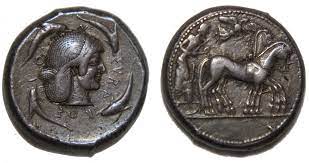Overview
The Temple of Athena, also called the Athenaion, was the crown jewel of what was—at the very least least according to Cicero—the most beautiful of all Greek cities, Syracuse. Directly in the heart of of Ortygia, not far from the famous springs of Arethusa, the building was a testament to the Hellenic, cultured, and pious nature of the city.
Out of all the monuments here, the Temple of Athena is significant in that it is still used for worship, currently as the Catholic cathedral of Syracuse. In place of honoring Athena, the building now honors Our Lady and is colloquially known for the Doric columns still visible as Santa Maria delle Colonne, Saint Mary of the Columns.
History
Although the Temple of Athena was commissioned around 480 BC, pieces of it dated to many years before. Sometime before the Temple of Athena was created, there was a different Doric temple, likely also dedicated to Athena, which was demolished in order to build the Athenaion.
A second, different temple was constructed around 530 BC directly adjacent to the location where the Temple of Athena would be built. This temple (see above) featured Ionian order and occupied the area where, in modern day Syracuse, the Muncipio building stands. The building was demolished sometime before or during the construction of the Athenaion, and pieces of this Ionian temple were used in the construction of the Temple of Athena.
From its time as a temple (leftmost scheme) the building went through significant renovations. Between the 649-660 AD, Bishop Zosimus of Syracuse had the temple converted into a church. The walls of the cella were carved into additional columns and the walls were added between the Doric columns in Byzantine style (middle scheme). Around a thousand years later, yet more walls were added and a baroque façade was installed, giving the church its present appearance (rightmost scheme).
Origins of the Temple
The Temple’s Location
The Temple of Athena at Syracuse is located on the island of Ortigia which constituted the majority of the city of Syracuse during the construction of the temple. Syracuse itself became one of the most influential cities in Sicily in large part due to the efforts of the Deinomenid family and the subsequent tyrants of the city.
Located on the eastern coast of Sicily, Syracuse would come to play an important role both in its repulsion of the invading Carthaginians under the rule of Gelon, but also in its upset victory against their Athenian enemies during the famous siege of the city during the Peloponnesian War. The city sits at a particularly important crossroads between the Greeks in the East, the Etruscans in the North, and the Carthaginians to their West and South. For an island already at the crossroads between cultures, they sit at the center of the action.
The Temple and Himera
The Temple of Athena at Syracuse was commissioned by, and built during the reign of, Gelon, the first of the Deinomenid tyrants of the city. Built around the year 480 BC, it was meant primarily to be a dedicatory offering to the gods for the triumph over the Carthaginians at the battle of Himera in the same year.

The battle of Himera was fought outside the city of Himera in Northern Sicily. According to the account of Diodorus, Gelon was able to successfully deceive the larger Carthaginian army by disguising a contingent of his cavalry as Carthaginian allies and sneaking into their camp near dawn. After they arrived inside they set the Carthaginian ships on fire, killed Hamilar (the commander of the Carthaginians and the father of Hannibal), and routed their army, relieving the besieged city of Himera and forcing an end to the Carthaginian invasion of the island.
Gelon and the Temple
Since the Deinomenid clan was a priestly family, Gelon felt that erecting a temple was the most fitting act of gratitude for his victory. By commissioning this temple, Gelon hoped both to give the proper recognition to the gods for their aid in the battle and to solidify his own reputation among the Syracusans as a man of high culture and great piety.

Although largely remembered as a man of war and military expansion, Gelon was deeply concerned with his reputation as a man of culture and fostered a deep respect for the arts. Instead of using the wealth and power he acquired and solidified in the wake of the Battle of Himera, he used his influence to create a lasting piece of art that would exemplify his connection to Greek culture and learning.
The Temple after Gelon
The Sicilian Expedition
In 415 BC, Athens sent two military expeditions to Sicily during the Peloponnesian War to aid their allies on the island and bring a number of cities, Syracuse among them, into the Athenian Empire. After laying siege on Syracuse for several months, the Athenians were eventually repulsed and the entire army was destroyed in an upset victory for the Syracusans. This victory was so important for the Syracusans that it is said by Plutarch about four centuries later that:
I learn that down to this day there is shown among the treasures of a temple in Syracuse a shield which is said to have been the shield of Nicias [the Athenian general]
Plutarch, Life of Nicias 28.5
This information from Plutarch implies that the Temple of Athena was one of the most important, if not the most important, of Syracuse’s temples since it housed this monumental artifact of their history for so long. The temple, then, was not merely a place for religious worship, but also an enduring statement about the history and legacy of Syracuse.
Roman Governance
By the time of the Late Roman Republic, however, the temple had, with the rest of the city, fallen on hard times due to mismanagement and greed. Due to Syracuse’s fame for both its natural and architectural beauty, it had become the object of plunder for one Roman governor in particular, Gaius Verres. In his famous court oration against Verres, Cicero describes the beauty of the temple and that:
There was a cavalry battle of their king Agathocles [the Syracusan tyrant], exquisitely painted in a series of pictures, and with these pictures the inside walls of the temple were covered
Cicero, In Verrem 2.4.122
It seems that after the time of Gelon, and before the Romans, there was a restoration of the temple that added depictions of the famous tyrants of Syracuse, especially Agathocles, to the interior. The importance of this temple, then, to the Syracusan tyrants and people did not vanish even after the Deinominds had long been out of power in the city.
Today
Today the building is still used as a Catholic Church, but recently, through the cooperation of municipal officials, scientists, historians, and a creative projector company, the façade of the church was illuminated with the image of the front of the Temple of Athena, with the columns, roof, triglyphs, and metopes all precisely where they would have been in ancient times.
During the week, visitors may enter for two euros and see this fantastic monument, or, for free on Sundays, churchgoers take part in the building’s 2,500 year purpose—religious worship.
Bibliography
- 2023. The Athenaion of Syracuse Comes Back to Light. Goboservice. (https://goboservice.com/en/projects/back-to-light-lathenaion-of-syracuse/ )
- Holloway, R. Ross. 1991. The Archaeology of Ancient Sicily. London: Routledge.
- Hall, H. 2024. Greek temples of Sicily. World History Encyclopedia. (https://www.worldhistory.org/article/1402/greek-temples-of-sicily/ )
- 2020. Syracuse, Temple of Athena. Livius. (https://www.livius.org/articles/place/syracuse/syracuse-photos/syracuse-temple-of-athena/ )
- 2023. Temple of Athena. (https://www.italia.it/en/sicily/siracusa/temple-of-athena)
- Wikimedia Foundation. Temple of athena (Syracuse). Wikipedia. (https://en.wikipedia.org/wiki/Temple_of_Athena_(Syracuse)
- Winter, F. E. 1976. Tradition and innovation in Doric design I: Western greek temples. American Journal of Archaeology 80(2): 139–145.